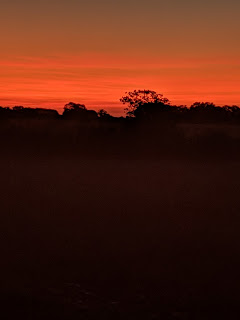 |
| Dusk descending |
Mammals however were emerging from their lying up places. We saw two different Red foxes: the first a large grizzled and greying old dog fox, then a much more svelte and younger vixen. Three Brown hares were next to reveal themselves, moving around having left their forms. (A form is a shallow scrape made in the ground.)
Then we saw three species of deer in good numbers: 4x Roe, 4x Muntjac and 2x Chinese water deer. One mixed group of species was unusual 2x Roe and 1 each of Muntjac and Chinese water deer all within a few feet of each other feeding happily. This provided a great opportunity to observe the features that differentiate the species.
 |
| A poor record shot of a Roe deer |
Chinese water deer were first introduced to the UK in 1929 after escaping from Whipsnade Zoo. Later escapes and deliberate releases saw their numbers begin to increase steadily with the greatest numbers in East Anglia due to the abundance of their favoured wet and marshy habitat. They are in sharp decline in their native China and it's now thought that the UK has over 10% of the world population.
 |
| Bodham church (taken in daytime) |

















































